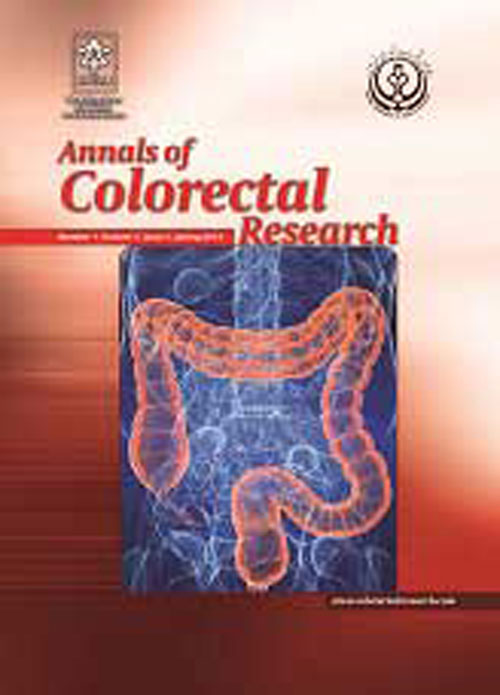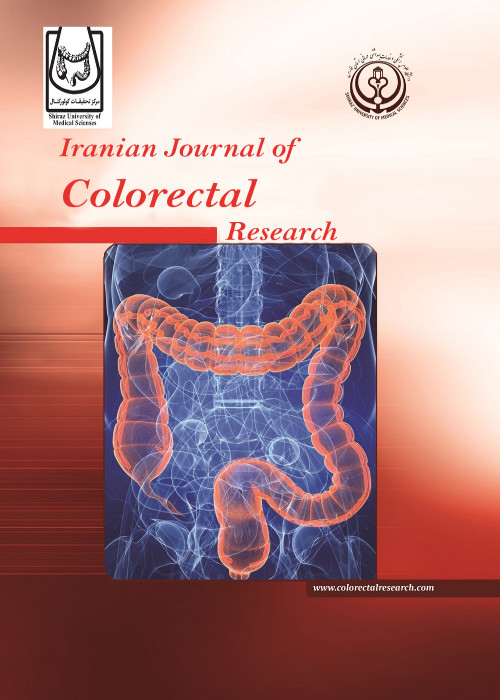فهرست مطالب

Iranian Journal of Colorectal Research
Volume:8 Issue: 2, Jun 2020
- تاریخ انتشار: 1399/03/12
- تعداد عناوین: 8
-
-
Page 1INTRODUCTION
Anterior resection is a commonly performed surgery for rectal cancer worldwide. It is associated with a wide spectrum of complications which include haemorrhage, pelvic sepsis, wound infection, anastomotic breakdown, deep vein thrombosis, peripheral nerves injury, impotence and urological dysfunction. However acute aortic thrombosis post anterior resection is a very rare complication.
CASE PRESENTATIONWe report a rare case of aortic thrombosis in a 67 year old gentleman following anterior resection for rectal cancer.
DISCUSSIONWe also discuss its possible causes as there are many postulations to the cause of this devastating complication. Prolonged surgery, abnormal blood coagulation in cancer patient, lithotomy position and the presence of peripheral vascular disease are predisposing factors contributing to this rare acute aortic thrombosis in our patient. A standard routine neurovascular examination of the extremities should be done in the postoperative period to help detect early any neurovascular complication. The use of prophylactic anticoagulant such as fondaparinux, low molecular weight heparin or low dose unfractionated heparin are strongly recommended in high risk surgery patients undergoing a major surgery which helps prevent thromboembolic episode following surgery.
Keywords: Anterior resection, aortic thrombosis, Rectal Cancer, surgical management -
Page 2Background
The risk of local recurrence in colorectal cancer has been associated with the length of clear distal margin in the specimen taken during original resection. It has been reported that there is significant specimen shrinkage after fixation in formalin. This study is aimed to quantify this degree of shrinkage and to investigate the factors for specimen shrinkage.
MethodsThis research was a single centre prospective study. All adult patients who underwent colorectal surgery for cancer had demographics, surgical details and cancer staging and pathology recorded. Colonic specimens were measured immediately post resection including the total length, the mesenteric length and the distal length from the palpable tumour. Multiple logistic linear regression was applied to identify factors associated with distal margin shrinkage.
ResultsRight-sided colectomy specimens had an inconsistent degree of shrinkage. Left-sided colectomy specimens showed an average shrinkage of 20% (CI 4% – 36%). The only other factor observed that had statistically significant association on the shrinkage of distal margins in specimens was increasing tumour size.
ConclusionsSpecimens resected during anterior resection for colorectal cancer have a consistent level of shrinkage. Locally advanced tumours were observed to have an association with specimen distal margin shrinkage, however the mechanism is unclear. This new evidence can assist intra-operative decision making to allow adequate distal margin resection.
Keywords: Colorectal neoplasm, Colorectal Surgery, formalin, margins of excision -
Page 3
Short term outcomes of Endoscopic Pilonidal Sinus Laser Treatment: a Single Centre experience. Pilonidal sinus (PS) is a widespread pathologic condition. The etiology of Pilonidal Disease (PD) is in favor of an acquired cause. Multiple surgical options have been advocated. In the last few years a minimally invasive approach to PD has been proposed. We performed a retrospective analysis of short-term surgical outcomes of combining EpSiT approach with the use of a radial laser fiber in the treatment of PD in a Single Centre. At our Proctology Centre, we performed 10 consecutive Endoscopic Pilonidal Sinus Laser Treatment procedures in the period from march 2019 to september 2019. The review of our initial experience suggests that the combination of fistuloscopy and laser ablation in treating fistulizing PD is feasible, safe and reproducible. Pilonidal sinus (PS) is a widespread pathologic condition. The etiology of Pilonidal Disease (PD) is in favor of an acquired cause. Multiple surgical options have been advocated. In the last few years a minimally invasive approach to PD has been proposed. We performed a retrospective analysis of short-term surgical outcomes of combining EpSiT approach with the use of a radial laser fiber in the treatment of PD in a Single Centre. At our Proctology Centre, we performed 10 consecutive Endoscopic Pilonidal Sinus Laser Treatment procedures in the period from march 2019 to september 2019. The review of our initial experience suggests that the combination of fistuloscopy and laser ablation in treating fistulizing PD is feasible, safe and reproducible
Keywords: Pilonidal Disease, Laser ablation, Fistuloscopy, Minimally Invasive Surgery -
THE FOUNDAMENTAL ROLE OF POSTOPERATIVE CRITICAL CARE IN GYNECOLOGIC ONCOLOGY SURGERY: A BRIEF REPORTPage 4
The value of postoperative critical care in gynecologic oncology surgery is crucial for the patient’s further postoperative course. For that reason different levels of postoperative care should exist, in order to identify in an early stage the possible complications and handle them properly . Strict indications of who should be admitted or not, should be defined and surgeons as well anesthesiologists should be aware of them. On the other hand, longer stay in hospital increases the likelihood of complications such as nosocomial infections and late ambulation, increasing morbidity and mortality. Therefore, longer stay in critical care units should be avoided, by predicting if patients are able to move to the general ward and later exit from the hospital. The next step is to set strict protocols for the indications of admission and decreased hospitalization by an accepted scientific team. These protocols should be applied universally in order to achieve the best possible outcomes in patients’ postoperative course.
Keywords: Critical care, Gyn, oncology, postoperative care -
Page 5Background
Due to its multiple forms of debut hidradenitis suppurativa has classically been a diagnostic challenge as well in the differential diagnosis. Prevalence of perianal fistula in patients with hidradenitis suppurativa ranges form 6,6% to 67%. The aim of the study was to assess both conditions.
Methods A retrospectivechart review from 2000 to 2018 using the ICD-9-CM, coded with 705.83. for patients with hidradenitis suppurativa was conducted. Hurley’s three stage classification was applied. Diagnosis and relevant patient characteristics were assessed and the presence of associated perianal fistula. Endoa-nal ultrasound (EAU) was performed in 61% of the patients with perianal hidradenitis and perianal fistu-la, and magnetic resonance imaging (MRI) in 19%.
ResultsOf 143 cases with hidradenitis, sixty two cases (43,4%) presented perianal (perineal/buttocks) location. Of them 93,5% were men. Twenty-one percent were associated with perianal fistulas being 6 of them complex ones associated with Hurley stage II and III. Treatment for the latter included: loose setons in 4 patients with Crohn’s disease and in 2 non Crohn’s disease with complex fistulas, 4 fistulotomies and 2 fistulectomies in low transphincteric fistulas and 1 with incision and drainage.
ConclusionPerianal fistula should be treated according to associated diseases and type of fistula. Association of hidradenitis and perianal fistulas may be higher than expected and the relation of severe hidradenitis with complex perianal fistulas should be studied further. Endoanal ultrasound and MRI may be useful tools to assess HS with complex perianal fistulas, but the iconographic patterns of hidradenitis and Crohn’s disease should be kept in mind as both may be associated.
Keywords: Hidradenitis suppurativa, Anal Fistula, Crohn’s disease, diagnosis of hidradenitis suppurativa -
Page 6Introduction
Open abdominal surgery exposes the intestine to negative ventilation (20°C, 0-5% RH), which along with the large surface area of peritoneum has the potential to cause loss of body heat. This study examined whether the warmed, humidified CO2 (WHCO2) can reduce heat loss and reduce postoperative pain.
MethodsA randomized controlled trial was performed at a tertiary colorectal unit (Concord Repatriation General Hospital, The University of Sydney, Australia). The study group received WHCO2 at a rate of 10L/min. The control group did not receive any insufflation during the operation. Patients were over 18 years of age undergoing elective open colorectal operations. Core body temperature measurement was made every 15 minutely with a trans-oesophageal probe. Postoperative pain was assessed via: (1) duration of use of patient controlled analgesia (PCA), (2) total oral morphine equivalent daily dose (oral MEDD).
Results39 Patients were recruited in the study, with 20 patients receiving WHCO2. There was no difference in the core body temperature between the WHCO2 and the Control group (36.1 vs. 35.9°C, p=0.35). There was no difference in the % of the operating time where core body temperature dropped below the lower limit of normal of 35.8°C (28.4% vs 35.8%, p=0.51), or to the level of hypothermia of 35°C (7.7% vs. 13.4%, p=0.50). No difference in postoperative PCA duration, as well as MEDD, were noted between the CO2 group and control group.
ConclusionWHCO2 had no effect on core body temperature during open colorectal surgery and the postoperative pain experienced.
Keywords: Humidified, warmed Carbon dioxide, Pneumoperitoneum, Core body temperature, Postoperative pain, Colorectal Surgery -
Page 7
Lateral pelvic lymph node dissection for advanced low rectal cancer has generated much discussion in the literature in last few years. Whilst it is still being debated as to whether it constitutes a locoregional disease amenable to surgery, or whether it is a distant metastases requiring neoadjuvant therapy, what is clear is that patients with enlarged lateral pelvic lymph nodes have higher rate of recurrence. In this review, we have analysed the current evidence and recommendations for lateral pelvic lymph node dissection. If advanced low rectal cancer (stage II, stage III) below peritoneal reflection, the decision to perform LPLND depends on (1) size of LPLN on MRI (>5mm) prior to neoadjuvant chemoradiotherapy and (2) non-responsive LPLN after CRT (LPLN >5mm before and after CRT). LPLN does prolong the operating time, and greater blood loss, however, is not associated with any greater morbidity. Preservation of the neurovascular structures, including the obturator nerves, hypogastric nerves, and the inferior vesical arteries must be identified and preserved. We have also described the key steps in performing lateral pelvic lymph node dissection.
Keywords: lateral pelvic lymph node, low rectal cancer, neoadjuvant therapy -
Page 8Introduction
Gut microbiota is a major component of the intestinal luminal environment and plays important roles in colorectal cancer. Object: systematically review all the existing literature on the association of mucosa-associated and fecal microbiota with incidence, location, and stage of colorectal adenoma and carcinoma.
MethodsThe scientific search was done up to July 2018. The search was limited to the English language with predefined and proper keywords. Among 616 articles some of them were eliminated due to some reasons. The inclusion and exclusion criteria were defined. In the next step two reviewers (M.M and Z.K) independently scanned the titles of all retrieved articles, removed duplicates, and identified potentially relevant abstracts for further assessment. The Newcastle-Ottawa Scale (NOS) for assessing the Quality was used for quality control.
ResultFinally, 54 articles were entered into the study. Fusobacteria 39 (72%), Firmicutes 22(40%), Bacteroidetes 20 (37%), Proteobacteria 15(27%), Actinobacteria 10(18%) was the most prevalent phylum which was found in colorectal cancer patients. Among these taxa some of them were increased in colorectal cancer patients compared to the control; on the other hand, some taxon was declined in colorectal cancer patients. Besides this, in some taxon there were controversies among articles.
ConclusionEarly detection of CRC is essential because patients whose cancer are detected at an early stage have more chance of survival. Until now there are several studies have demonstrated the potential rule of gut microbiota to be used for detection of CRC, but there is not any predefining protocol for screening. Although we found lots of articles which were published in this area, for defining a precise microbiota profile we need large multicenter case-control studies, where can show the effect of most important confounding factors like nutrition, ethnicity, physical activity, smoking consumption, and genetic background.
Keywords: Colorectal cancer, Colorectal neoplasm, CRC, Screening, Microbiota


